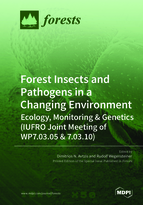Forest Insects and Pathogens in a Changing Environment: Ecology, Monitoring & Genetics (IUFRO Joint Meeting of WP7.03.05 & 7.03.10)
A special issue of Forests (ISSN 1999-4907). This special issue belongs to the section "Forest Ecophysiology and Biology".
Deadline for manuscript submissions: closed (15 January 2019) | Viewed by 41338
Special Issue Editors
Interests: forest entomology; biogeography and distribution of forest insects; innovative methods to control the damaged caused by forest pests
Special Issues, Collections and Topics in MDPI journals
Special Issue Information
Dear Colleagues,
After the successful conclusion of the Joint Meeting of IUFRO’s 7.03.05 & 7.03.10 working parties, and given the exciting and novel studies that have been presented in the framework of the meeting, I am very happy to inform you that the journal Forests kindly agreed to host a Special Issue with the most interesting results. The natural environment is constantly changing due to anthropogenic activities, and their impact on forest pests and pathogens cannot be neglected. Frequent insect population outbreaks, invasion of exotic pathogens and the unpredictable damages they cause, all point out to the importance of collaborations not only at regional but more importantly at international scale. Only this exchange of knowledge can serve as a protective net against the challenging and changing environment. To that, we encourage studies from all fields, ranging from experimental studies and monitoring techniques to model predictions and genetic analyses, to contribute to this Special Issue in order to promote knowledge that will fortify forest ecosystems in the future to come.
The Special Issue is also open to receiving regular submissions that discuss a relevant topic.
Dr. Dimitrios N. AvtzisDr. Rudolf Wegensteiner
Guest Editors
Manuscript Submission Information
Manuscripts should be submitted online at www.mdpi.com by registering and logging in to this website. Once you are registered, click here to go to the submission form. Manuscripts can be submitted until the deadline. All submissions that pass pre-check are peer-reviewed. Accepted papers will be published continuously in the journal (as soon as accepted) and will be listed together on the special issue website. Research articles, review articles as well as short communications are invited. For planned papers, a title and short abstract (about 100 words) can be sent to the Editorial Office for announcement on this website.
Submitted manuscripts should not have been published previously, nor be under consideration for publication elsewhere (except conference proceedings papers). All manuscripts are thoroughly refereed through a single-blind peer-review process. A guide for authors and other relevant information for submission of manuscripts is available on the Instructions for Authors page. Forests is an international peer-reviewed open access monthly journal published by MDPI.
Please visit the Instructions for Authors page before submitting a manuscript. The Article Processing Charge (APC) for publication in this open access journal is 2600 CHF (Swiss Francs). Submitted papers should be well formatted and use good English. Authors may use MDPI's English editing service prior to publication or during author revisions.
Keywords
- Forest pests
- Forest pathogens
- Climate change
- Population outbreak
- Invasive insects
- Bark beetles
- Forest Management
- Phylogeography







